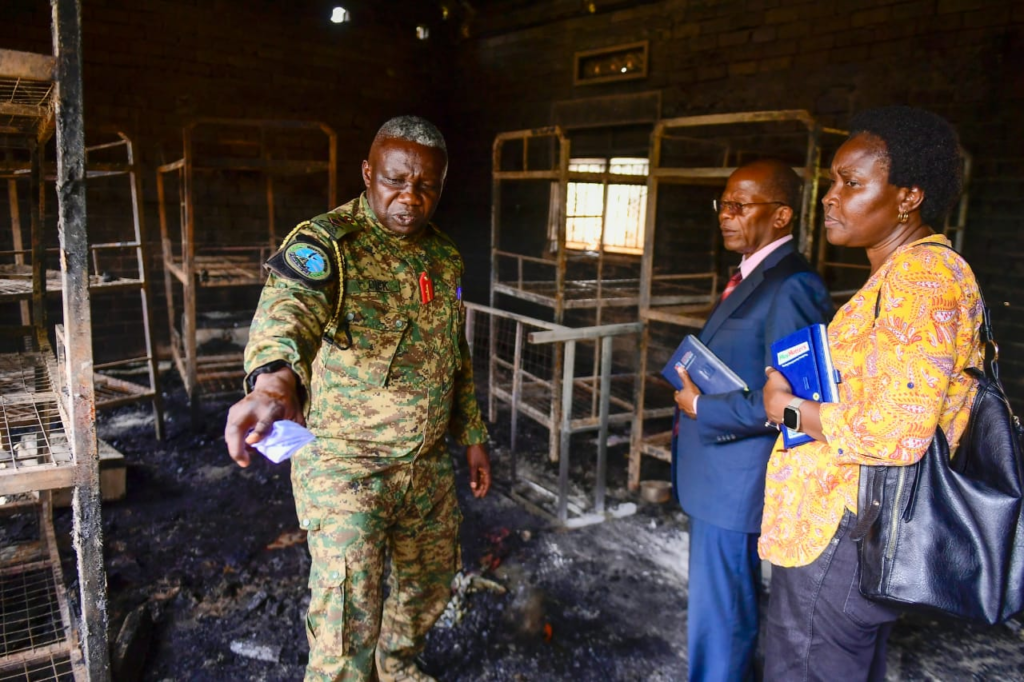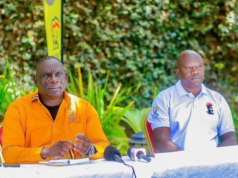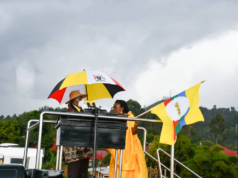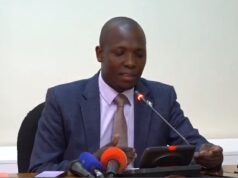
Security agencies linked the attack to the Allied Democratic Forces (ADF), one of the notorious rebel groups based in the DRC.
The Ministry, in wake of the attack dispatched a team led by state minster for higher Education, John Chrysostom Muyingo, the Permanent Secretary, Ms Ketty Lamaro, and the commissioner for private schools to assess the situation.
First lady Janat Kataha Museven while addressing journalists at State House Nakasero on Saturday 17 June moved to assure parents that the government would ensure the safety of the students adding that the nearby school with opver 700 students had not been attacked
“Today, our nation mourns the devastating terrorist attack on Mpondwe Lhubiliriha Secondary School in Kasese District near the DRC border, claiming the lives of 37 children, with another five hospitalized. Initially, 25 deaths were reported, but the count tragically increased.
Due to my ongoing quarantine, I couldn’t personally visit the site. Instead, Hon. Muyingo, accompanied by the Permanent Secretary, Ministry of Education and Sports, and the Commissioner for Private Schools, is on the ground assessing the situation.
With the President’s assistance, we’re providing support for the bereaved families during this trying time. We call upon everyone to offer prayers for the affected families and community, while also urging vigilance to uphold the safety of our children in schools.
We request the media to report responsibly, considering the ongoing grief, and providing comfort and hope. I remain confident that the UPDF, with divine guidance, will ensure those responsible face justice.
On behalf of the Ugandan Government, the Ministry of Education and Sports, and myself, I extend heartfelt condolences to the families, students, staff of Lhubiliriha Secondary School, and the broader community affected by this tragedy.
Uganda Peoples’ Defence Forces (UPDF) spokesman Felix Kulayigye said the six kidnapped were taken towards Virunga National Park, a vast expanse that straddles the border. “UPDF embarked on pursuing the perpetrators to rescue the abducted students.”
National police spokesman Fred Enanga said the attack on the privately owned school occurred in the district of Kasese, about two kilometres (1.2 miles) from the DRC border.
Daniel Bwambale, a lawyer and expert on government affairs in Kampala, told Al Jazeera the attack was preventable.
“There is no reason why this attack should have taken place. There are air assets available, unmanned aerial vehicles, artillery and most definitely enough personnel to pursue the ADF,” he said, blaming the authorities for failing to act on the intelligence.
Florence Kabugho, a legislator for Kasese, told reporters there were “very many unanswered questions” given the heavy military presence so close to the border. “Where was this security when these killers came to Uganda?” she said.
It was not ADF’s first attack on a school in Uganda. In June 1998, 80 students were burned to death in their dormitories in an ADF attack on Kichwamba Technical Institute near the DRC border. More than 100 students were abducted.

Burned ‘beyond recognition’
Joe Walusimbi, an official representing Uganda’s President Yoweri Museveni in Kasese, said, “Some bodies were burnt beyond recognition.”
Major-General Dick Olum, the army’s commander for western Uganda, said the attackers stayed in the town two days before the attack, marking their target. He said an unidentified youth had gone to the school to check its layout before the attack.
“That is how the attackers came and locked the boys’ door. The boys really tried to fight back, but they were overpowered. The attackers had lit mattresses,” Olum told reporters from Mpondwe.
“In the girls’ dorm, they found their door open, hence killing them and cutting them.”
Barbaric’
The DRC and Uganda militaries have launched joint operations against the ADF in recent years.
Bulama Bukarti, an analyst with Uganda’s Daily Trust newspaper, said the armed group generally responds to military pressure by targeting civilians.
“They want to cause maximum casualties in order to prove to their enemies that they are still alive,” he told Al Jazeera. “This is a barbaric and unacceptable attack. It is an attack on innocent children. It is an attack on the future of Uganda and Congo. No child, no parent should have to go through this.”
In April, the group was blamed for an attack there that left at least 20 people dead. It is believed to have been responsible for killing 36 people in March during an overnight attack on the village of Mukondi, in eastern DRC.
Ugandan authorities for years have promised to track down ADF fighters “at home and abroad”.
ADF rebels, when under military pressure, “divert” their pursuers’ attention by splitting into small groups that then launch violent attacks in other places, said Olum.
“A typical ADF signature because … they are under huge pressure, and that’s what they have to do to show the world that they are still there, and to show the world that they can still do havoc,” said Olum.
Deadliest militia
UN Secretary-General Antonio Guterres demanded the kidnapped students be immediately released. “Those responsible for this appalling act must be brought to justice,” he said.
Ugandan authorities also blamed the group for deadly suicide bombings in the capital, Kampala, in 2021 and launched joint air and artillery raids in the DRC against it. But the measures have so far failed to stop the ADF’s attacks.
The ADF, which the United States has deemed a “terrorist” group, is considered the deadliest of dozens of armed militias that roam mineral-rich eastern DRC. In March this year, the US announced a reward of up to $5m for information leading to the capture of the ADF’s leader.
In 1995, the ADF was formed by a coalition of rebel forces – including the Uganda Muslim Liberation Army and the National Army for the Liberation of Uganda (NALU) – to fight against the Museveni administration.
Over the years, the group was backed by subsequent governments of DRC that were keen on subverting Rwandan and Ugandan influence in the country.
But in 2013, the ADF began attacking Congolese military targets, leading the army to fight back. Consequently, its leader Jamil Mululu fled to Tanzania in 2015, where he was arrested and extradited to his home country to stand trial on charges of terrorism.
In recent years, the ADF has been referred to itself as the Madina at Tauheed Wau Mujahideen – City of Monotheism and Holy Warriors (MTM).






